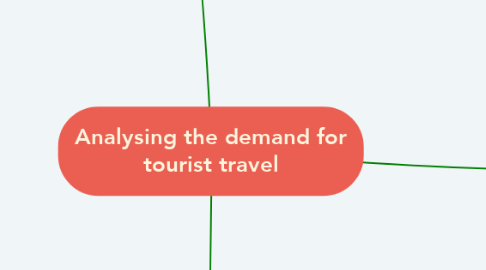
1. Understanding why people travel
1.1. Tourist travel motivators
1.1.1. a desire to escape from a mundane environment
1.1.2. the pursuit of relaxation and recuperation functions
1.1.3. an opportunity for play
1.1.4. the strengthening of family bonds
1.1.5. prestige, since different destinations can enable one to gain social enhancement amongst peers
1.1.6. social interaction
1.1.7. educational oppoturnities
1.1.8. wish fulfilment
1.1.9. shopping
1.2. Types of tourist travellers
1.2.1. the organised mass tourist
1.2.2. the individual mass tourist
1.2.3. the explorers
1.2.4. the drifter
1.3. Characteristics of tourism demand
1.3.1. should not be equated with tourism motivation
1.3.2. is the outcome of tourists' motivation
1.3.3. can be expressed as the sum of realistic behavioral intentions to visit a specific location
2. Motivation, tourist transport research and psychological issues
2.1. Transport multiple role
2.1.1. Full inhibitor
2.1.2. Significant constraint
2.1.3. Functional Ink
2.1.4. Integrated element
2.1.5. Dominates the experience
2.2. Traveler's motive patterns
2.2.1. Suggested core motivation
2.2.2. Additional motivational emphases
2.3. Psychological issue
2.3.1. A complex
2.3.2. The significant of life-cycle and the need for psychographic studies to understand the motives behind travel is identified and highlighted
2.3.3. Life-cycke factors, group motivation and a classification of the multiple roles of transport is emphasizes into core
3. Forecasting the demand for tourist transport
3.1. Definition and characteristics
3.1.1. essential for commercial operators
3.1.2. minimise the risk of failure or maximise the possibilities of success
3.1.3. is the process associated with an assessment of future changes i nthe demand for tourist transport but not an exact science
3.1.4. is a techique used to syggest the future pattern of demand
3.2. Methods
3.2.1. Principal methods
3.2.1.1. Principal methods
3.2.1.1.1. The projection by extrapolation of historic trends
3.2.1.1.2. Extrapolation, subject to the application of weights or variables
3.2.1.1.3. Structured group discussion amongst a panel of tourism transport experts used to assess factors determining future traffic forecast
3.2.2. Basic types
3.2.2.1. Qualitative changes
3.2.2.2. Quantitative changes
3.3. Variables
3.3.1. Relate to factor directly and indirectly infuencing tourist travel
3.3.2. Most common variables used
3.3.2.1. Number if tourist trips
3.3.2.2. Total tourist expenditure and expenditure per capital
3.3.2.3. Market share of tourism
3.3.2.4. The tourism sector's share of gross domestic product
3.4. Approaches
3.4.1. Time-series model
3.4.1.1. Used statistical technique
3.4.1.2. Only indicate what happening by pbserving the trend
3.4.2. Econometric models
3.4.2.1. Searching for statistical relationship
3.4.2.2. The level of complexity involved is considerably
3.5. Functions
3.5.1. Establish how consumer demand for tourist transport has shaped previous trends and how these may change in the future
3.5.2. Assess how the demand for tourist transport will change on a global basis and within different countries over the next decade
